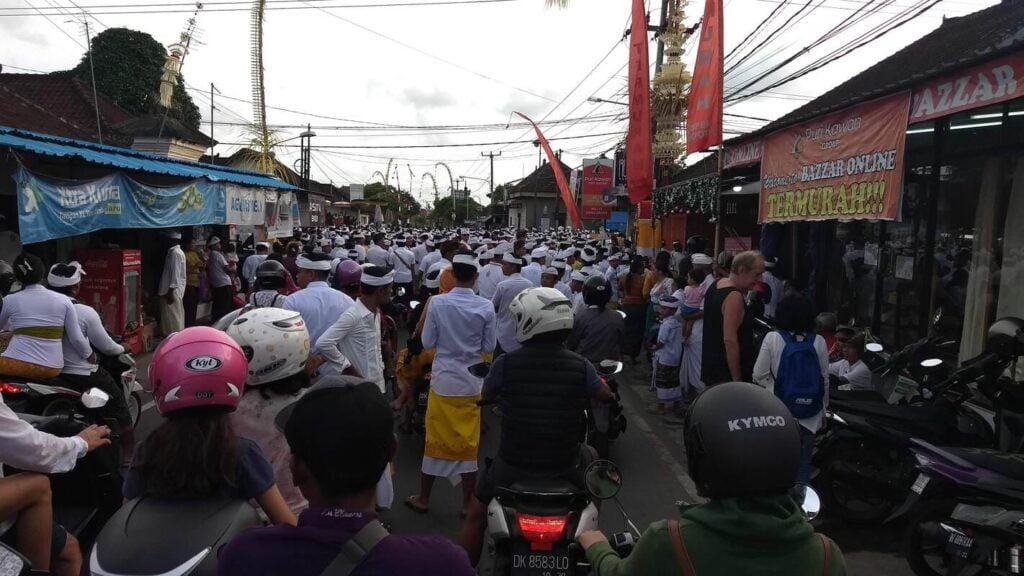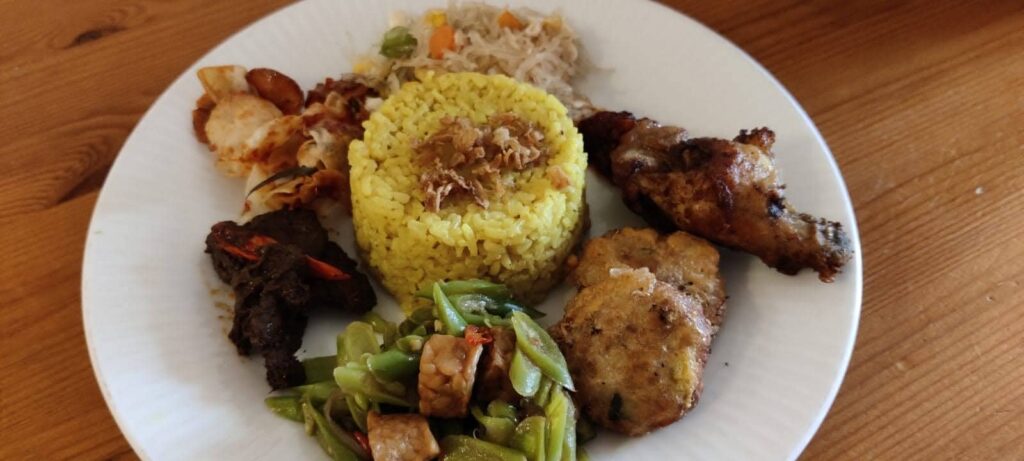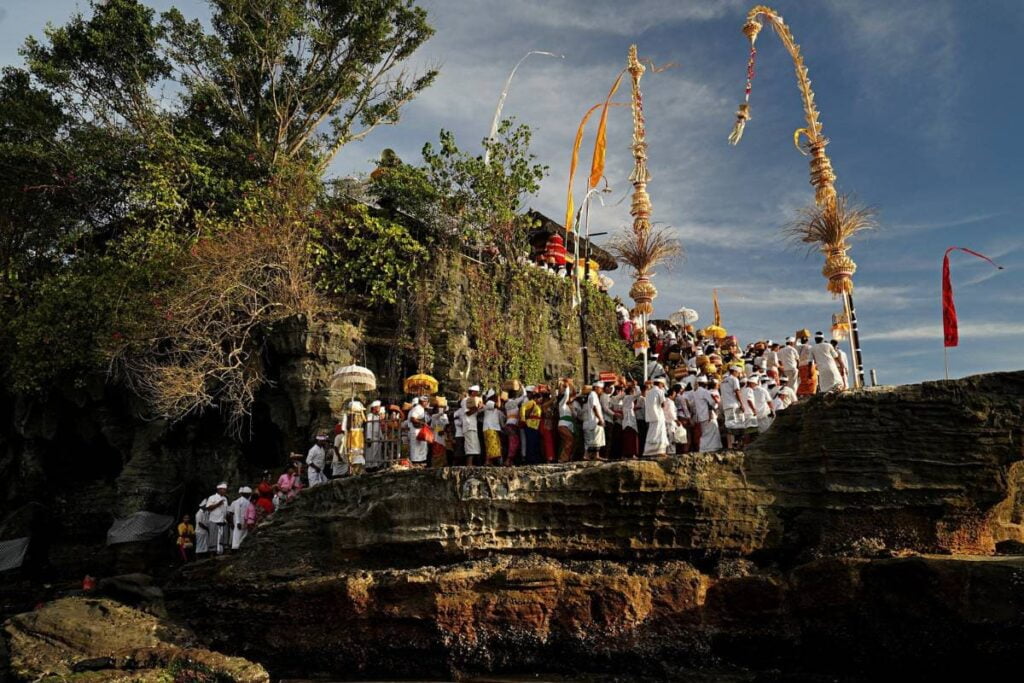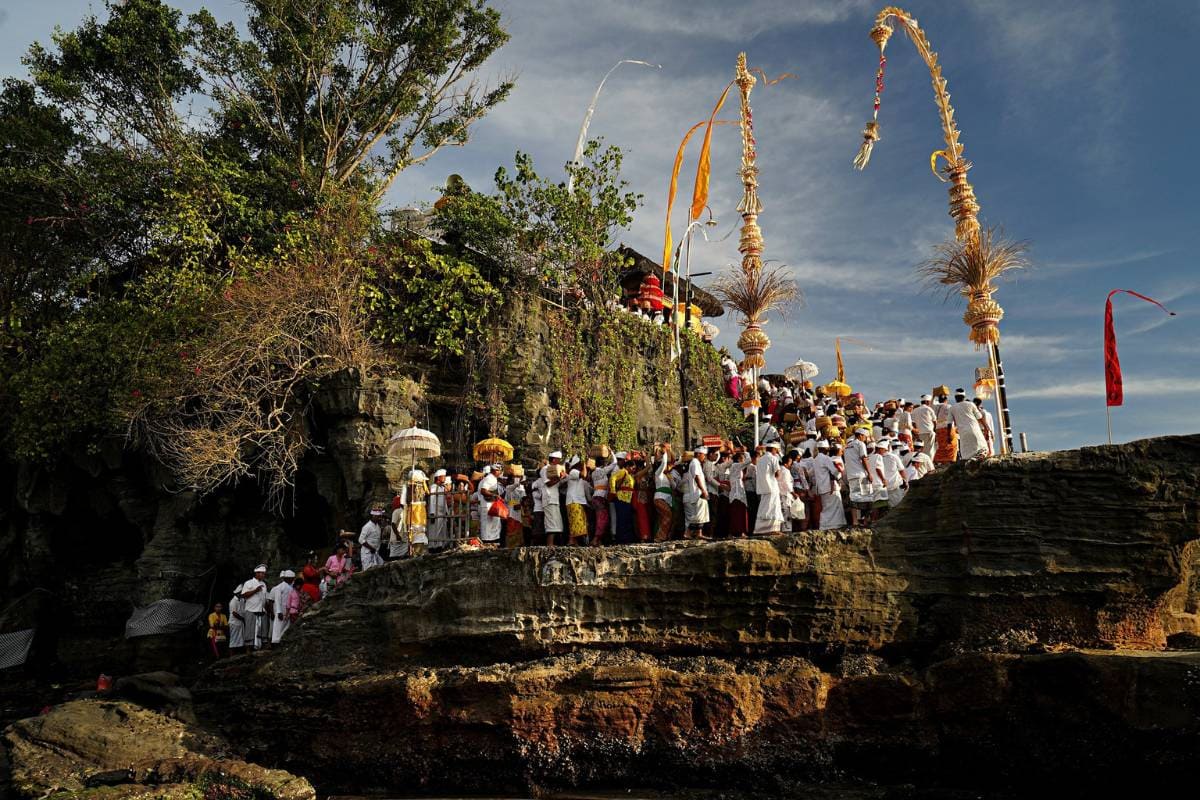In the island of Bali, Galungan and Kuningan stand out as special times. The Balinese celebrate good over evil. These festivals are deeply spiritual. They’re about respecting God and welcoming the spirits of ancestors. During these festivals, Bali comes alive with unique decorations. “Penjor,” or decorated bamboo poles, line the streets.
Held every 210 days, these festivals span 10 days. Galungan kicks off the festivities, with Kuningan wrapping them up. During this period, the Balinese, dressed in traditional attire, gather at temples. They offer prayers and gifts. It’s an amazing cultural thing to witness and experience.
TIP: It can be very busy on the roads during Galungan.

Preparation Day: The Eve of Galungan
The day before Galungan ceremony holds significant importance in Bali. Known as ‘Penampahan Galungan,’ it’s a day of preparation and anticipation. On this day, the Balinese engage in various activities to ready themselves for the festival. Homes and temples are adorned, and the atmosphere buzzes with excitement.
Families come together to prepare traditional dishes, an integral part of the celebration. There’s also a focus on spiritual readiness, with many engaging in prayer and reflection, setting the tone for the sacred days ahead. This preparation day is not just about physical readiness; it’s a time for mental and spiritual alignment, ensuring that the essence of Galungan is embraced in its entirety.

The Historical and Cultural Roots of Galungan and Kuningan
The celebrations of Galungan and Kuningan go back centuries. The story of an ancient king, Mayadenawa, who defied the divine authority of Sang Hyang Widhi, the Supreme God in Balinese Hinduism. This clash between the king and the gods represents the everlasting victory of dharma over adharma, the triumph of good over evil.
These festivals are of a time when the Balinese connect with their history and spiritual beliefs. Galungan day celebrates the creation of the universe and the victory of divine power. Kuningan, following ten days later, marks a moment of gratitude and reverence.
Through rituals, offerings, and communal gatherings, these festivals reinforce the cultural identity of Bali. They are a vivid reminder of the island’s rich heritage, blending spirituality with everyday life. In essence, Galungan and Kuningan are more than just dates on a calendar; they are a living, breathing part of Bali’s history and cultural legacy. (source: Wikipedia on Galungan)
Celebrating the Victory: The Symbolism and Traditions of Galungan
Galungan is a time of joy in Bali. This is about the time when the good prevails. The people celebrate the victory of dharma. This festival is rich in symbols and traditions. The most famous symbol is the “penjor.” You can see banjars and households putting up these poles. They are decorated with fruits, offers, coconut leaves. The whole street becomes festive.

During Galungan, Balinese Hindus pray and make offerings. These acts honor the victory of good over evil. This marks the time when the ancestral spirits of deceased relatives are visiting the earth. The Balinese have a deep responsibility to be hospitable to these spirits. They welcome their past ancestors with prayers and offerings throughout their homes. This hospitality is a key part of the festival’s spirit.
The festival is filled with special foods and gatherings. Families come together. They share meals and stories. This is a time for community and remembering moral values. Everywhere in Balinese villages, communities it looks very festive. Most locals do something we call “pulang kampung”, return to visit the village at home.
TIP: Learn more about the culture of Bali:
Ritual Cadence: The 210-Day Cycle of Galungan and Kuningan
Galungan and Kuningan follow a unique calendar. In Bali, they use a 210-day cycle called the Pawukon calendar. This calendar sets the dates for these festivals. Galungan marks the start of the cycle. Kuningan happens 10 days later. This cycle repeats every 210 days.
This calendar is different from the usual yearly calendar. It’s special to Bali and its Hindu traditions. The Pawukon calendar is not just for timekeeping. It’s also tied to their spiritual life. It guides them on when to celebrate, pray, and perform rituals.
Celebration of Kuningan day: The Culmination of the Festivities
The last day of the celebration is Kuningan day. This day happens 10 days after Galungan starts. Kuningan festival in bali is about saying goodbye to the spirits of ancestors. They believe these spirits visit Earth during Galungan.
On Kuningan, people in Bali make special offerings. These offerings include yellow rice, which symbolizes prosperity. The rice is a way to thank the spirits and gods. It’s a sign of gratitude.
The day before Kuningan is also important. People prepare for the final day. They cook, pray, and get ready to farewell the spirits. This preparation is a big part of the celebration.
Kuningan is not just a closing day. It’s a day of reflection and thanks. It reminds people of the blessings in their lives. It’s a time to be with family and think about the future.
During these Balinese holidays most Balinese are free from work, a lot of shops are closed. Javanese often continue to work and operate, but it’s a lot calmer on the island.
Hi I am Dwi. I am a blogger, travel agent and a mom of a lovely daughter and wife to a supportive husband. I customize and plan tours in Bali and islands nearby for a living and have been doing this for more than 14 years. Get in touch via contact [at] taletravels.com
